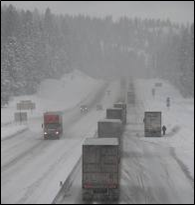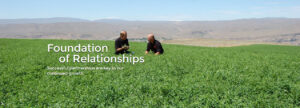As the winter weather has arrived, it’s time to think about highway safety. As the leading exporter of hay and straw products in the world, Anderson Hay is commited to safe, on time delivery of our products to ports along the west coast. This means that our truck drivers are navigating ddaily through adverse weather conditions. Our highest priority is the safety of our team and others on the road as they travel throughout the Western United States this winter. Many start their days long before the sun rises and while the rest of us are still warm in our beds. There are also many who are still traveling after the sun has set and we are home safe with our families. Our team members are out on the roads, crossing mountain passes and battling adverse weather conditions. They venture into wind, ice and snow to ensure safe delivery.This winter season as trucks move to and from port facilities on the coast it’s important to remember the safety of everyone on the roads. When it comes to trucks it’s always a good idea to keep a good distance. Leave plenty of room between your vehicles and give them space to maneuver. Remember that the longer and heavier the vehicle is the longer it will take it to stop.
Be sure you have plenty of time to get to your destination, people in a hurry drive faster and more aggressively than conditions can allow. Slowing down can keep the roads open longer. Avoid using cruise control. It’s best to control your speed manually. Even the slightest touch of your breaks to slow down or deactivate cruise control can cause you to lose control of your vehicle on icy spots or standing water. According to the Washington State Department of Transportation, most often the pass is closed in order to remove vehicles that have slid and are blocking traffic. Though traffic delays can be frustrating for the average commuter, state wide commerce can take a major hit. Slow driving; accelerating, turning and breaking are important when the roads are wet and icy.
Plan ahead to allow for weather and make sure to check the status of the roads you will be traveling. Dial 511 to be connected to local weather and road conditions. You can also find information on travel conditions on the well maintained websites hosted by the Departments of Transportation in the Western states:
Washington: www.wdot.gov
California: www.dot.ca.gov
Oregon: www.tripcheck.gov
Idaho: 511.idaho.gov
Nevada: www.nevadadot.com
Montana: www.mdt.mt.gov
Utah: www.udot.utah.gov
Wyoming: dot.state.wy.us
Arizona: www.azdot.gov
New Mexico: www.nmshtd.state.nm.us
Colorado: www.coloradodot.info
This system will tell you the current road conditions as well as what they expect for the rest of the day. You can also find out if traction tires, all-wheel drive or chains are required under the current conditions. It’s also the place to see pre-planned closures for avalanche control and snow removal.
Be especially careful around chain-up and removal areas on mountain passes. Though these areas tend to have more lanes, vehicles are slowly pulling into and out of traffic. Chaining up requires drivers to leave their vehicles and head into freezing, wet and windy weather. With visibility low and ability to react slowed, drivers should drive cautiously. If you carry chains for the pass, be sure to also carry reflective gear such as a safety vest to make yourself visible to other drivers. Keep your headlights on to ensure greater visibility whether driving or pulled to the side of the road. Even in the daylight, headlights are important in keeping your vehicle visible to everyone else on the road.
Working together we can help keep people safe on the roads this winter season.


